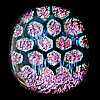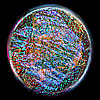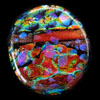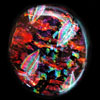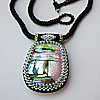- sale
- new items
- lovely beads
- wedding beads
- beads for teens
- for custom order
- newsletter
- recognition
- testimonials
- birthstones
- zodiac signs
- jewelry guide
SHOP BAG
![]() in your bag 0 items
in your bag 0 items
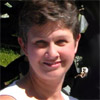
I'm Linda Roberts, and I live in San Diego, California. I am a self taught artist using books, magazines and DVD's to teach myself bead stringing, beadweaving, bead embroidery and jewelry design. I have taken classes in PMC (precious metal clay), polymer clay, stone cabochons, wire wrapping, silversmithing, lampworked glass beads, and glass fusion. To say that I love variety is an understatement.
My route to creating jewelry actually started with my love of rocks and stones. After collecting many beautiful rocks, I wanted to know more about them so I joined the San Diego Gem and Mineral Society and a whole new world opened up to me. While attending many different gem and mineral shows I was awed by all the beautiful handcrafted pieces of jewelry I saw. It was at one of these shows that I discovered dichroic glass.
My love for beads developed gradually, beginning about 10 years ago. At first I was hesitant to express my fascination with them, but the beads won and I'm now an admitted beadaholic with no hope or desire for recovery. It is very fulfilling to encircle my treasured stone and glass cabochons with tiny seed beads and create unique jewelry.
In June 2009 I attended a local bead show and was looking for dichroic glass cabochons to use in my beadweaving. I met Paul Fernandes, owner of Fusionglass Co. in La Mesa, CA. He told me about the glass fusion classes they offered at their store and I knew it was something I had to do! The class was taught by his partner, Debbie Solan, and it was so much fun. In just a couple hours I had designed three potential cabs.
Normally the store fuses the glass in their kilns and the students return in two days to pick up their cabs. But I was determined to learn how to do the whole process myself. I had an older (but hardly used) kiln at home just waiting for some action.
My Sierra kiln was not specifically made for glass but actually works very well. It has three built in programs for PMC and one program that can be set by the user. I was given a guide sheet for fusing the glass from the class instructor, but it had eight different settings and I could only program in four settings. I did a lot of research on the internet and found these helpful articles:
I also read two books:
- The Fused Glass Handbook, by Gil Reynolds
- More Than You Ever Wanted to Know About Glass Beadmaking, by James Kervin
I had also saved an article out of a magazine (sorry, I do not recall which one) called "Two-Timing Kiln" by Kathleen Bolan that addressed how to specifically program my kiln for annealing glass beads.
To properly fuse and anneal glass, the kiln must be ramped up or down to different temperatures, at different rates, and held at these temperatures for different periods of time. If the glass is cooled too quickly it will not anneal properly and will potentially crack.
Using all of the information I could find, I programmed four settings of Rate (degrees of F/Hr), Temperature, and Hold Times into my kiln and said a little prayer as I added my potential cabs and hit the start button. I had to wait about 10 hours until the next morning to see if I had been successful. I could hardly sleep due to the anticipation.
I awoke early the next morning and threw on my clothes so I could run out to the shed where I have my studio and kiln. I held my breath as I opened the kiln door. There they were - my first three dichroic glass cabochons in all their glory. I almost cried from relief and joy.
And thus my love affair with dichroic glass cabochons was fulfilled. It has been 6 months since my first class in glass fusion and I'm still in love. I had to find a source for dichroic glass that I could afford. It is quite expensive. One large round sheet of dichroic glass can cost several hundred dollars. I wanted smaller pieces and lots of variety.
Searching the Internet, I discovered a glass site that meets the needs of small shop artists like me: www.coe90.com. All of the glass is COE 90 so I don't have to worry about it not being compatible. They offer glass by the pound, variety scrap bags, 4"x4" squares of dichroic glass and all supplies at very reasonable prices. I have not been disappointed with any product I have purchased from them.
I sell my dichroic glass cabochons and beadweaving on my Etsy site, and I have created three necklaces using beadweaving around my dichroic glass cabs: Aurora Borealis, Martian Landscape, and Persuasion. My cabs have been given a very positive reception from fellow beadweavers.
In just three short months, I have sold over 35 cabochons. Sabine Lippert, a marvelous beadweaver from Germany, bought some of my first cabochons and created some beautiful jewelry by combining them with beadweaving. You can view three pieces of jewelry using my cabs on her blog try-to-be-better.blogspot.com. It's written in German, but the pictures speak for themselves. To date she has made three necklaces with my cabochons: Paradise, Starshine and Sunlight, and Metaluna.
The process of creating dichroic glass cabochons
My gallery on MyLovelyBeads.com
About author:
| Linda Roberts, San Diego, California, USA | |
| Email address: | llroberts9@gmail.com |
| Website: | www.myheartbeadsforyou.com |
| Gallery on Flickr: | flickr.com/people/beadsforever |
| Blog: | beadsforever2.blogspot.com |
| Etsy Shop: | www.beadsforever.etsy.com |


